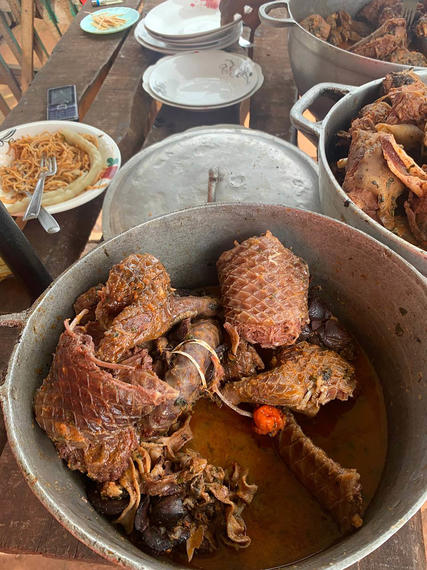How does wildlife trafficking operate in Central Africa?
Cameroon is at the center of wildlife trafficking in Central Africa. It is both a source country of animal products as well as a transit route for contraband from neighboring Republic of Congo, the Democratic Republic of Congo and the Central African Republic. All roads lead to Douala, Cameroon’s largest city and economic capital, home to both the region’s largest seaport and a major international airport. From here, exports can readily be made worldwide.
Most large-scale movements of animal products are made during the cocoa harvesting season, when it is easier to hide animal products amid legitimate cargo. Given the volume of cocoa being transported at this time, not all cargo is searched. Some transporters might be aware that they are carrying illicit animal products along with their agricultural goods, but transporters are only part of a complex network of poachers, middlemen, traders and sometimes government officials.
Certainly, wildlife trafficking is not a new problem in Central Africa. Ivory, bones, scales, skins and other animal products have long been desirable commodities, both at home and internationally. Not all animal products are destined for export; bushmeat remains a source of income and is considered a delicacy by some in the region. However, global prices matter most: after a fall earlier in the decade, ivory prices, for example, have rebounded worldwide. After the market shocks caused by the COVID-19 pandemic, wildlife trafficking has regained ground. Poaching is thus strongly driven by foreign demand, although local factors such as conflicts between farmers and conservation areas such as national parks also play a role.
What is the role of China, and other Southeast Asian countries, in Central Africa’s wildlife trafficking trade?
China, as well as Vietnam, and to a lesser extent Laos and Malaysia, are key destinations for wildlife contraband from Central Africa. Between 2016 and 2022, I documented at least 25 major seizures of wildlife products from the region. Most of these shipments were destined for either China or Vietnam. Many more instances of trafficking are likely to have gone undetected. Use of animal products in traditional Chinese medicine (TCM) is a principal reason for wildlife trafficking, keeping prices high and demand steady. By some estimates, the value of the TCM market is already greater than $100 billion, with further growth anticipated. Beyond TCM, some see investment in wildlife products as a good store of value, one hardly affected by inflation.
Although China has taken some action to curb the pangolin trade in recent years, legal, domestic markets in China are still open. Obviously, black-market trading is not accounted for in official statistics, so the true volume of this, and other animal product industries, is probably much higher than is reported. The net effect is that the hunt for animal products continues unabated, with little consideration for the consequences this has in the countries and communities of origin.
How does wildlife trafficking affect peace and security in Central Africa?
Corruption facilitates trafficking and trafficking incentivizes corruption. This cycle of corruption can lead to violence, as even those law enforcement officers dedicated to rooting out trafficking may fall victim to the distortion of priorities within their organizations and bureaucracies. Unfortunately, corruption remains endemic at both local and national levels in Cameroon.
More widely, the lucrative nature of trafficking has incentivized poachers to become increasingly militarized in their approaches, sometimes intimidating local residents, and sometimes leading to clashes between different poaching networks. During my research in Cameroon, villagers near the Dja Faunal Reserve, one of the last largely intact rainforests in the region, told me that they have been threatened at gunpoint and with arrest if they are seen to hinder any organized poaching efforts. Poaching causes insecurity for local communities, especially those living near protected areas such as national parks or reserves, making such communities targets for criminals and armed groups. Even worse for security, in some cases, the military and police are involved in trafficking operations, particularly in facilitating the transport of wildlife products.
What can be done?
It’s a worrying picture, but there are steps that can be taken to improve the situation. The fight against wildlife trafficking is often focused on the bottom of the pyramid, on those doing the poaching itself. More attention is needed on those orchestrating the larger deals and running these transnational networks. These include the elite sponsors of trafficking, who are not always the most visible in everyday trafficking but are among the most influential. It takes two to be corrupt, so those who facilitate payments to officials need to be pursued much more systematically, both in African states and in international jurisdictions.
There is a need to address consumer behavior, too. Those purchasing and consuming these products, especially given its size, those in China, need to be better informed of the harms being caused by their choices as consumers. Damage is being done not only to a seemingly distant environment, but to ordinary people, too. There is irony that in the name of healing and medicine, much avoidable harm — to peace and to biodiversity — is actively being promoted.
Alexia Tata is a researcher and management consultant from Cameroon. From 2021 to 2022, she participated in the China-Africa Early Career Scholars Program of the U.S. Institute of Peace.
Source: usip


